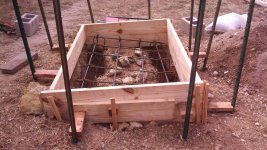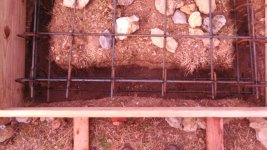Wire is the worse thing in the world you can use for concrete pads because it is impossible to walk on it when spreading the mud and keep it in the middle of the mud. Like Dave said, it always ends up at the bottom of the pad accomplishing nothing. I've seen this 100 percent of the time in every slap that I have opened up or demolished. It's a nice theory, but totally impossible to accomplish. The little game of saying they pull up the concrete as the work on it is a compete lie. It doesn't work and the only times you will see a crew doing that is when they first start working the mud for show, once the mud gets to flowing, there isn't any time for that little game, and it gets pushed to the bottom.
You didn't say what sized rebar you are using, but since this is such a small pad, number 3, which is also called 3/8's rebar is more then big enough. I cut lengths of it about four to six inches longer then the depth of your footings and hammer them into the dirt straight up and down every two feet all the way around so that the top of the rebar is about an inch higher then you want your rebar going across the pad. Then I tie one stick of rebar about four inches or so off the bottom of the footing onto those vertical pieces of rebar. Then I do it again with another stick at the level you want the rebar going across your pad. Then I lay out my grid with sticks every two feet from footing to footing and I put chairs under it to keep it off the ground. You don't have to buy the chairs for something this small. A rock works well, or you can even use short lengths of rebar hammered into the ground like you do in the footings. Just make sure not to have it higher then a couple inches below the height of your forms.
Are you mixing the concrete yourself with sacks like Quikrete from Lowes or Home Depot? I found that the 60 pound sacks are easier to handle and pound for pound are .2 cents cheaper then the 80 pound sacks. This isn't good quality concrete, but it's fine for what you are doing. If you want to make it stronger, you can buy a sack of Portland cement and add some of that to each sack you mix. Or you can buy the higher quality stuff, but I don't think that's really needed for something like this.
Mix it up as dry as you can to get the most strength out of it. It should not flow, you should have to force it where you want it once you dump it into the form. Jabbing it with a stich and tapping on the forms will help get rid of air pockets along the edge of the forms, but you will not get all of them and it really wont make a big difference strength wise as long as you get most of them and do it all the way around the forms.
Make sure you have your stakes on the outside of the form. I like to have them below my forms so I can screed over the forms without hitting the stakes. It's not that big a deal if you have the stakes higher, it just means you have to work around it. I use screws on my stakes and forms in case I need to adjust them before the pour. It is also easier to take them apart in my opinion. 2 inch sheetrock screws are great for this.
If you use too much water, it will form on the top of your pad and you will have to wait longer until you can work it smooth. There is a point where it's too wet, then it gets just right to work it. If it's drying too fast for you, add water from a bottle. If it's too wet and you have standing water, you have to wait. This might take an hour or more. If you don't wait and work it at the right time, it will be a mess. Finishing it off is an art and a big part of what you pay for when hiring a crew. Sticking with it and getting it right takes a lot of effort and elbow grease, but there isn't any other way to get it done.
Post pics of your forms before putting the rebar in and we will comment on how it looks. Then do the same after you install your rebar. Pictures are worth a million words!!!!
Eddie

